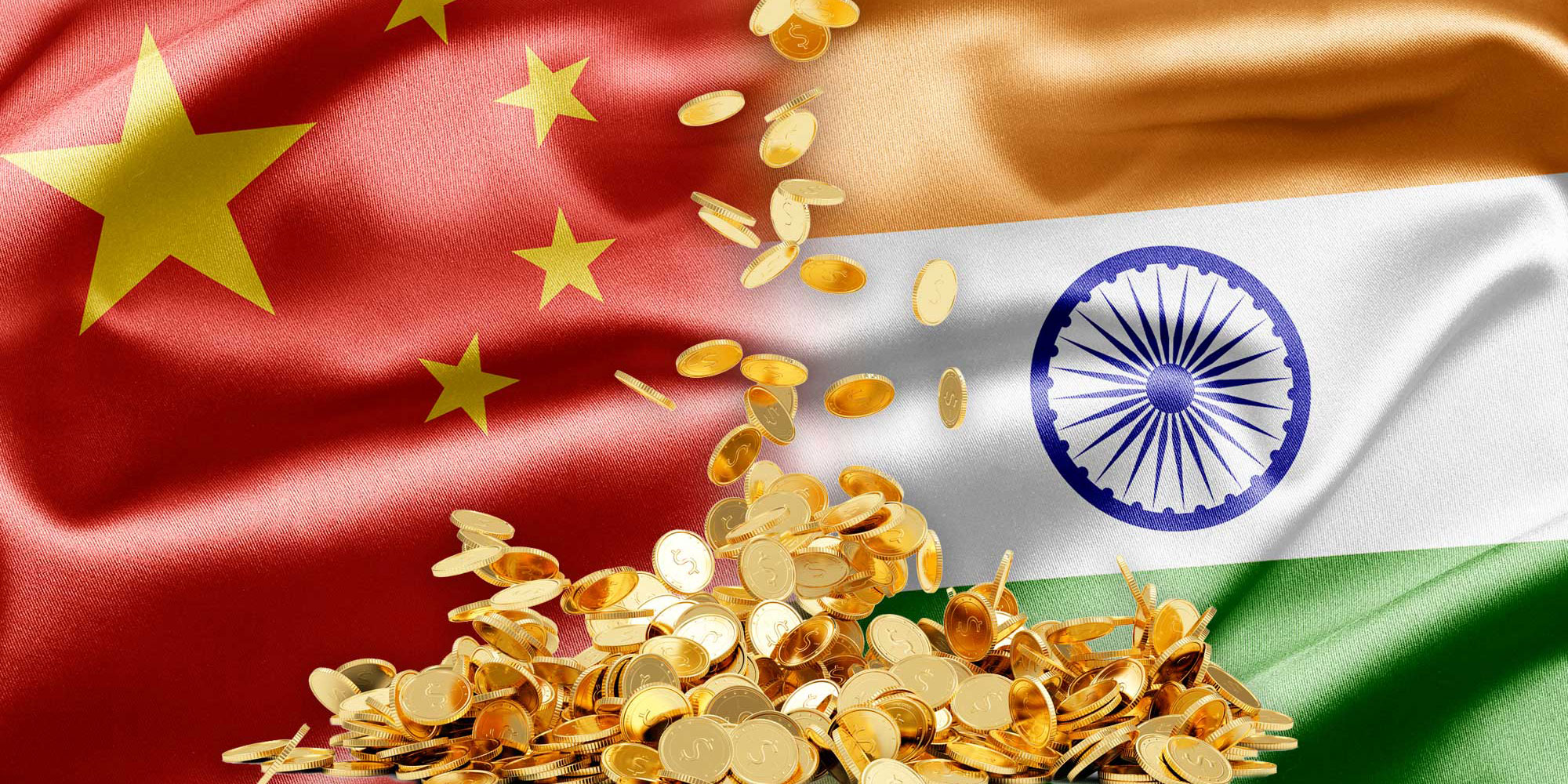Fending off Toxic Debt – A Closer Look at the Two Asian Giants’ Deteriorating Asset Quality
|
The banking industries in India and China are challenged by growing asset quality concerns amidst a rise in the volume of bad loans worth billions of dollars to politically allied and heavily debt-ridden borrowers, who are now in trouble. Consequently, non-performing assets (NPAs) in public banks have sharply increased, with aggregate banking system capital nearing regulatory minimums. The deteriorating financial health of banks has in turn increased the systemic risk of the sector, threatening the stability of the banking system. Indian authorities have stepped in aggressively, compelling lenders to recognize the full extent of bad loans and clean-up their books, while supporting the banking system through a series of capital infusions. Our analysis, suggests that the Indian banking system will continue to remain resilient unless NPAs more than double their reported levels.However, counterparts in China, faced with a similar dilemma, seem to still be ignoring the full extent of the problem. Given the banking system’s importance to the global economy, a stronger response by the government is warranted despite the ability of the economic powerhouse to withstand the reported deterioration in asset quality. |
Accommodative Monetary Policy – a Prominent Theme in India and ChinaThe Indian banking sector plays a pivotal role in the equitable distribution of credit in the country’s economic development. As per the Reserve Bank of India (RBI), the banking sector is adequately capitalised and well-regulated, which was reflected in it being resilient even during the global downturn in 2008. As of 2015, the country’s banking system was valued at USD 1.9 trillion (in terms of assets) (90% of GDP), and ranks as the fifth largest in the Asia Pacific. However, the sector contributed a mere 1% of global banking assets in comparison to China – which accounted for nearly 20% of global banking assets as of 2015. The Reserve Bank of India (RBI) has adopted an accommodative monetary policy stance since 2013, with the RBI easing or delaying tightening. The monetary easing came with a deceleration of inflation (to 5.9% in 2015 from 9.3% in 2012) on the back of a sharp drop in oil prices and softening commodity prices, strong economic growth (GDP growth increased to 7.6% in 2015 from 5.6% in 2012) and an improved fiscal situation (fiscal deficit reduced to 4.1% of GDP in 2015 from 5.7% in 2012). The debt fueled stimulus was aimed at accelerating a trickle-down effect through the Indian economy by making more cash available at a lower interest rate. Since January 2013, the RBI has cut interest rates by 150 basis points (bps) to 6.5% in 2016 from 8.0% in 2013. Further, as part of liquidity enhancement initiatives, the cash-reserve ratio was lowered to 4.0% in 2013 from 5.5% in 2012, with the rate on the marginal standing facility reduced by 250 bps (in several steps) to 7.0% in 2016 from 9.5% in 2013. 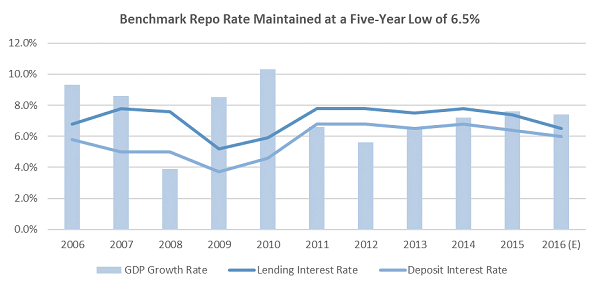 Source: World Bank national accounts data, and OECD National Accounts data files, RBI
Note: 2016 (E) GDP growth rate is based on the IMF forecast; however, the lending interest rate and deposit interest rate are actual figures
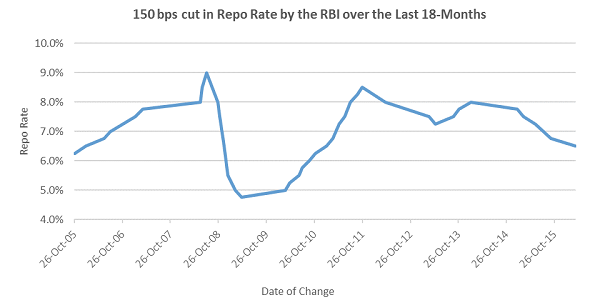 Source: RBI
Similarly, China, the largest banking system in Asia Pacific, adopted an expansionary monetary policy stance for a prolonged period since 2008, in a bid to defy any external shocks in the aftermath of the global financial crisis (GFC). Accordingly, interest rates which stood at 5.3% as of 2008 reached a record low of 4.3% as of 2015. 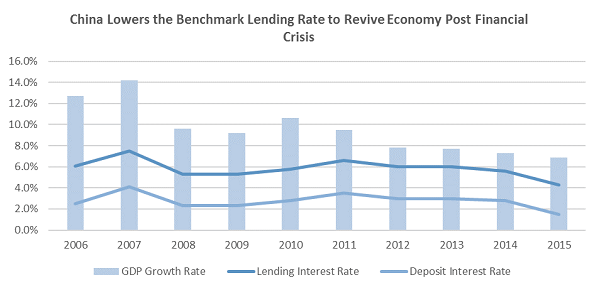 Source: World Bank national accounts data, and OECD National Accounts data files
Top 15 Asia-Pacific Countries by Total Banking Assets
Source: BMI Research, UZABASE |
Despite Monetary Stimulus, Credit Off-take in India Continues on a Downward SpiralRegardless of policy rates continuing to be well below historical norms, Indian banking sector credit growth has slowed since 2012 to a CAGR of 13.3% during 2012-15. This displays a significant deceleration compared to the credit growth CAGR of 23.2% during 2006-11, largely owing to demand and supply-side constraints. On the demand side, key sectors such as infrastructure (35% of bank credit in March 2016), demonstrated less credit-intensive growth due to a high number of stalled projects. Accordingly, credit off-take growth in the infra sector slowed to a record low of 4.4% YoY in March 2016 from 37.2% YoY in March 2011. Similarly, the power sector – the biggest drawer of bank credit within infra, recorded the sharpest deceleration in credit growth to 4.0% YoY in March 2016 – a fall from 41.9% in March 2011. Further, a large portion of the decline was also attributed to moderating credit aggregates, thereby constraining supply in the wake of banking sector risk aversion.  Source: RBI, Source: World Bank national accounts data, and OECD National Accounts data files
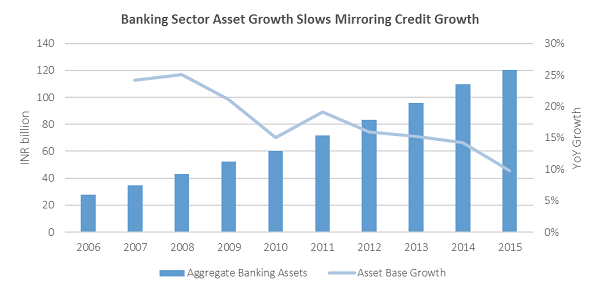 Source: RBI, Planning Commission- Government of India, Ministry of Statistics and Programme Implementation
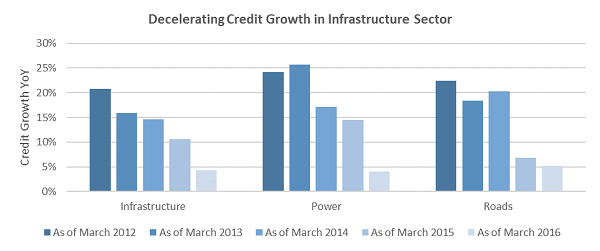 Source: RBI
In contrast, China saw a rapid expansion of bank credit owing to a prolonged expansionary monetary policy by the People’s Bank of China (PBOC), with banks being compelled to boost credit to state owned enterprises (SOEs) and local governments for major infrastructure developments. Accordingly, on the back of a healthy credit growth CAGR of 17.5% since the global financial crisis (during 2008 -15), banking sector tripled to USD 34 trillion against a GDP of USD 10 trillion (340% of GDP). 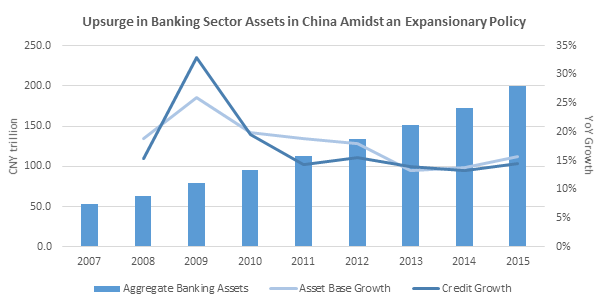 Source: IMF, CEIC, UBS Estimates, SNL Financial, People’s Bank of China, China Banking Regulatory Commission Annual Report 2013
Note: Assets data include consolidated assets of banking institutions within and outside China |
Rising Non-Performing Assets in Public Banks Resulting in Stricter Credit ControlSeasoning of the loan book amidst a credit cycle of rapid expansion (in 2006-11) led to a credit deadlock as a result of less stringent credit appraisals and competitive credit disbursals. Consequently, the gross non-performing assets (NPAs) in the Indian banking system rose at a CAGR of 30.8% during 2010-15 – significantly above the credit growth CAGR of 16.1% recorded for the same period. Accordingly, NPA as a proportion of total advances increased to 4.3% in 2015 from 2.5% in 2010, while further deteriorating to 7.6% in March 2016. As a result of the weakening performance, the Indian bank shares became the worst performing shares in Asia (ex-Japan), over the past year with 11 banks reporting losses for the quarter ended-December 2015. Moreover, the RBI expects gross NPA to worsen to 8.5% by March 2017 under its baseline stress test scenario. Furthermore, according to the RBI financial stability report June 2016, given the most adverse conditions, the gross NPA ratio may further worsen to 9.3% by March 2017, hampering the banking sector’s overall performance.  Source: RBI
 Source: RBI
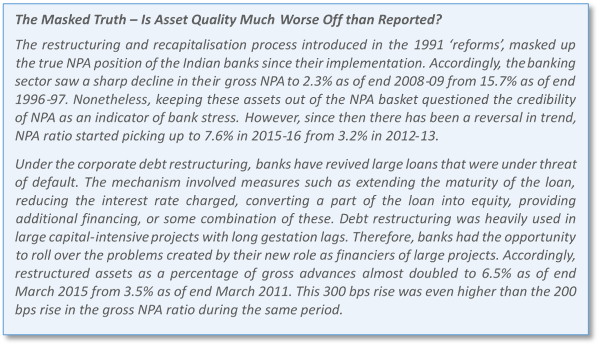 |
Majority of NPAs Reside on the Balance Sheets of State-Owned Banks under the Weight of Politically Driven Decision-MakingPublic sector banks, which account for 70% of the Indian banking system have performed the worst since 2012, with stressed advances (the combination of restructured standard advances and non-performing loans) clocking in at 13.5% in 2015, compared to 4.6% in private banks. Moreover, public banks’ gross NPA ratio registered at 5.4%, compared to the industry average of 4.3% in 2015, while rising to 9.3% of total advances in March 2016. The RBI further estimates that this ratio may worsen to 10.1% by March 2017. Moreover, according to a report by Credit Suisse, at state-owned banks, the un-provided NPAs are now at 30%–75% of their capital and un-provided problem loans (loans which are in trouble and could turn into NPAs) are at an even higher level of 65%–200%. Sectors including power and iron & steel formed a large part of the stressed assets, predominantly on the back of an overestimated demand and supply position (industry overcapacities), inflated project costs and poor project appraisals. The iron & steel sector, which accounted for a major part of the stressed loans was severely impacted due to sluggish offtake by Indian consumers and intense competition stemming from the Chinese market. Further, sectors such as infrastructure and engineering procurement & construction (EPC) were saddled with various issues, thereby delaying execution while challenging their economic feasibility. On a related note, lack of funding channels for local government in the absence of a deep corporate bond market and muted participation by pension funds negatively impacted the country’s banking system while aggravating the crowding out of lending to small businesses.  Source: RBI
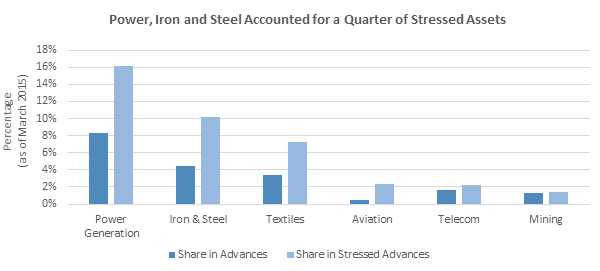 Source: RBI
Similarly, the Asian major – China, is also exposed to an exceptionally large low quality credit market as the banks were compelled to boost credit to SOEs, following the global financial crisis. The Chinese banking system is faced with the legacy of state utilisation of bank credit for financing the operations of SOEs regardless of their profitability or risk. Moreover, supported by an ultra-low interest rate regime, major infrastructure developments such as roads, energy plants and rail systems were completed. The boom in investments has however led to overcapacity in many capital intensive sectors such as steel, cement and mining. Meanwhile, since 2009 shadow banking activities in the Chinese banking system increased with top banks increasing their exposure in the property sector making them more vulnerable to a property downturn. The slowdown in economic growth spelt trouble for the banking system with revenues of borrowers now coming under pressure. Accordingly, the reported NPA ratio at China’s banks increased to 1.7% in 2015 from 1.3% in 2014, and further to 2.2% as of May 2016. Alongside the NPAs, in China there is another category of “Special Mention Loans” (loans with which borrowers are experiencing difficulties and which may threaten the financial institution’s position) totaling CNY 3.2 trillion as of 1Q 2016. When these are taken into consideration, the market estimates of the true NPA position reaches an alarmingly high of 15-19% of the loan book, as per the assessment by the brokerage CLSA. This definitely indicates a red flag. 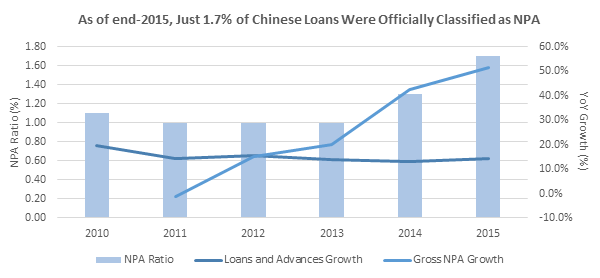 Source: CBRC
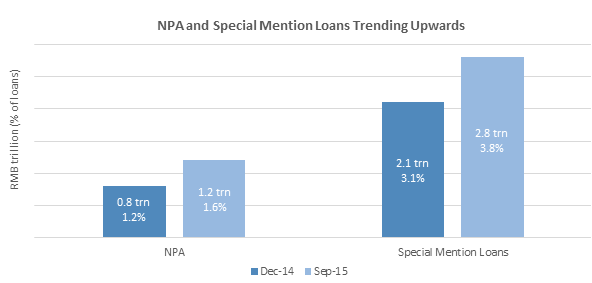 Source: CBRC, PwC Analysis
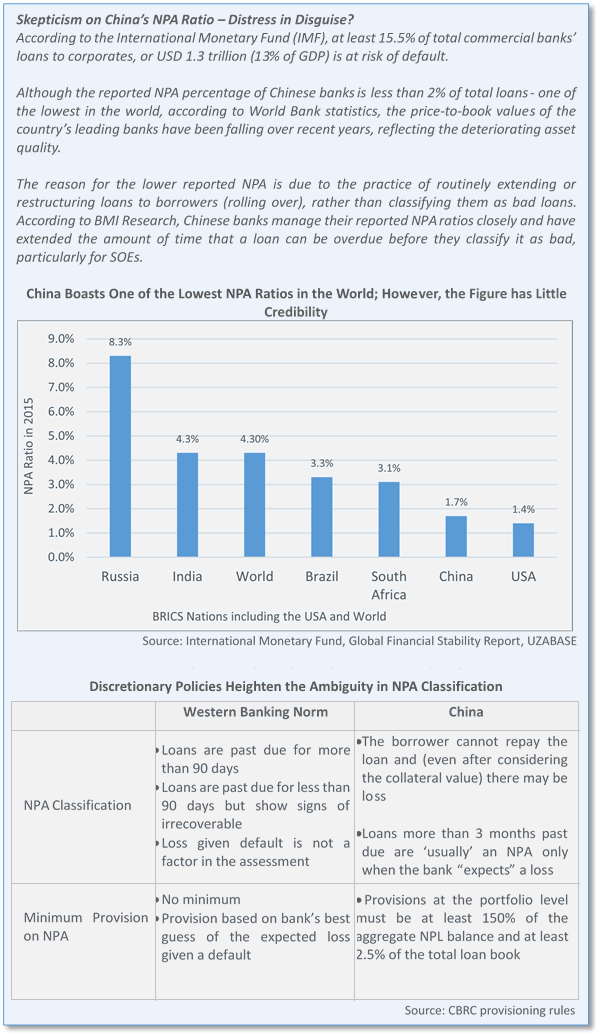 In China the build-up of bad debt has continued for 18 consecutive quarters exerting tremendous pressure on the banking system. The majority of bad loans are stemming from China’s Big four state-owned banks – Industrial and Commercial Bank of China – the world’s biggest lender by assets (accounting for 2.1% of global assets as of June 2016), China Construction Bank (accounting for 2% of global banking assets as of June 2016), Agricultural Bank of China and Bank of China – where each bank saw a nearly 100 bps increase in their NPA ratio as of June 2016 compared to the previous year. Moreover, on the back of souring bad loans, the loan loss provisions of the largest Chinese banks have diminished over the years, while these banks are now faced with a dilemma between breaching the 150% provisioning requirement or reporting a profit decline. 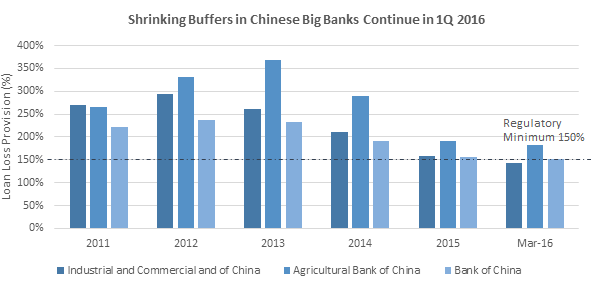 Source: The Wall Street Journal |
Deliberate Non-Payment, a Common Scenario in Both NationsAccording to the Credit Information Bureau (India) Limited (CIBIL), there were 6,819 willful defaulters in India owing INR 750 billion as of December 2015. This figure registered 51% growth since 2012 compared to INR 220 billion from 3,703 willful defaulters until December 2012. (The RBI defines willful default as deliberate non-payment of dues by the borrower despite adequate cash flow and good net worth). Although the banks have filed lawsuits against the top willful defaulters, the enforcement of law remains questionable with significant delays due to corruption and political influence. Another major limitation is the classification of these borrowers where the banks do not adopt a uniform policy when declaring a borrower as a willful defaulter. For instance, Kingfisher Airlines which owes an aggregate INR 69.6 billion to banks (2.2% of aggregate banking sector NPA), has been declared a willful defaulter only by the State Bank of India (SBI) and Punjab National Bank (PNB), with most other banks yet to adopt the classification. Similarly, in China a number of state-owned enterprises such as Bohai Steel have historically used their political connections to coordinate with creditors, while delaying debt servicing and extending repayments. Consequently, these structural shortcomings have left behind mountains of bad debt, threatening the stability of the banking system. Top Wilful Defaulters in India (As of December 2015)
|
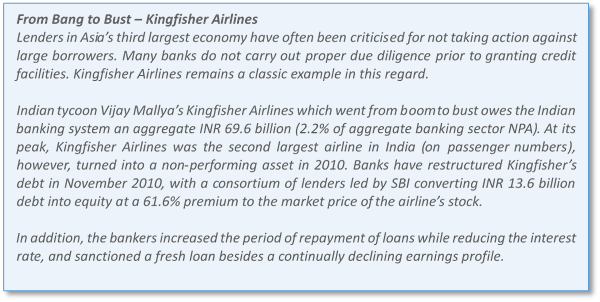 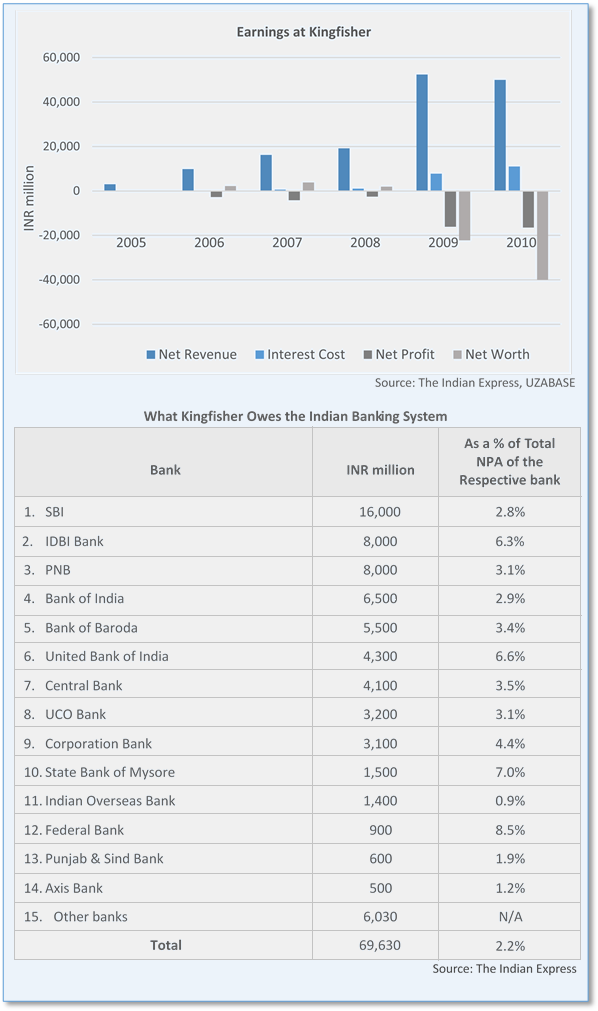 |
Banks Bite the Bullet – Write off Bad Loans, Taking a Hit on SolvencyIn line with the mounting bad loans, write-offs by banks surged at a CAGR of 44.1% during 2012-15, with public sector banks having written-off loans totaling INR 1,140 billion at a CAGR of 50.7%. The regulator hoped that the banks would find a way out of the problem, and hence did not intervene to address the toxic loan problem until the recent past. However, in line with the continually worsening asset quality and the consequential waive-off of defaulted loans, the RBI conducted an asset quality review (AQR) across the entire banking system (broadly similar to a stress test) in October 2015, to clean up the balance sheets of those troubled institutions. The RBI observations were encouraged to proactively and conservatively look at the troubled accounts and emphasised the recognition of restructured assets as NPAs while creating adequate provisions to cover restructured loans. Accordingly, fiscal 2015 alone witnessed a steep 55.3% YoY surge in write-offs as part of the balance sheet clean-up. Capitalisation ratios of the banking sector slipped to 12.9% in 2015 from 13.0% in 2014 (the RBI stipulates a Minimum Total Capital to Risk Weighted Assets Ratio (CRAR) of 9% for India – higher than the BASEL III requirement of 8%). Public sector banks continued to report the lowest Capital to Risk Weighted Assets Ratio (CRAR) at approximately 12%, whereas private sector banks’ (PVBs’) CRAR reached 16% as of 2015. The RBI also announced a March 2017 deadline for banks to clean-up their balance sheets, due to the high incidence of bad assets. Accordingly, following the clean-up and the planned capital infusion of INR 250 billion by the government, the capitalization ratios of the banking sector may hover in the range of 11.0%-11.5%, with CRAR of public sector banks further moderating to 9% – on par with the regulatory minimum. In the absence of a capital infusion in 2016 and 2017, CRAR would be 0.5% lower. Under various NPA scenarios, it could be seen that CRAR would drop below the regulatory requirement in the event actual NPAs reach 9-10% compared to the current 4.3% level in 2016. Impact on Banking Sector Capital (as of 2015) Given Various NPA Scenarios
Source: UZABASE
“We believe enough capital is available. While the profitability of some banks may be impaired in the short run, the system, once cleaned, will be able to support economic growth in a sustainable and profitable way,” – Former RBI Governor Raghuram Rajan ”As of now, the public sector banks are adequately capitalised and meeting all the Basel III and RBI norms. However, the government wants to adequately capitalise all the banks to keep a safe buffer over and above the minimum norms of Basel III. We have estimated how much capital will be required this year and in the next three years till financial year 2019,” – Ministry of Finance 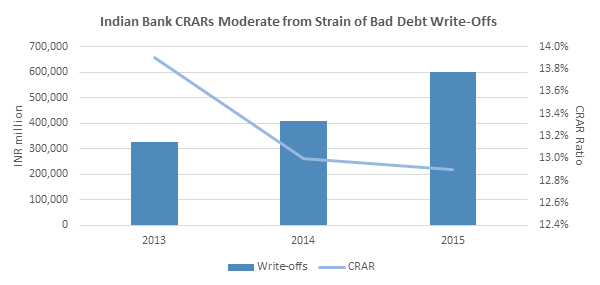 Source: RBI
RBI Intervention in terms of the AQR followed a Number of Pre-Operative Procedures
Source: The Indian Express, UZABASE
 Source: Government of India
Allocation Break-up of INR 250 billion Capital Infusion
Source: Ministry of Finance
Similarly, in China banks have written off more than USD 300 billion of bad loans in the past 3 years-compared a mere USD 1.8 billion worth of bad debt write-offs in India, in order to reassure investor confidence that the country can cope with its mounting NPA. |
What China can Learn from India’s Bold Approach – An Example from the Asian NeighbourThough the cleanup is still underway, India has become the front runner in addressing asset quality concerns which has scored some early success by taking prudential measures. Banks have now expedited the process of recovering bad loans from overextended tycoons like Mallya. In contrast, China, seems to still ignore the full extent of the problem. Even though Chinese banks have continually reported mounting bad debts, banks have still not curtailed lending. According to the PBOC, new loans worth USD 718 billion were disbursed in the first quarter of FY 2017-a threefold increase compared to the same period last year. Unlike India, given the systematic importance of China’s banking system to the world- considering its asset size, an NPA ratio of 10% would equal USD 3.4 trillion (34% of Chinese GDP) or 5% of world GDP. Further, this is even greater than the Indian GDP which is approximately USD 2.1 trillion as of 2015. This would exacerbate the need for proactive measures to address the potential loss, before the debt bomb leads to a crisis. Furthermore, according to the Bank of International Settlements, the corporates collectively owed USD 17.4 trillion as of September 2015 (177% of the Chinese GDP), which is staggering compared to the much lower USD 985 billion in India (50% of the Indian GDP).A bank with a cleaner balance sheet always looks more promising, as it indicates a stronger position to direct credit for economic development. Therefore, the biggest lesson that China can learn from India is the prudential recognition of bad loans without delaying their recognition by ways of restructuring, thereby, challenging the credibility of the reported figures. Additionally, the Chinese cabinet discussions regarding lowering the loan-loss provision ratio to 120-130% from its current level of 150% – a move to report larger profits in the banking system, raises a crucial question on the direction of the reforms. The earlier ratio was set when the asset quality was better than current levels, therefore lowering it further and making more funds available in a flagged economy may worsen the current scenario. “You can put lipstick on a pig, but it doesn’t become a princess, so dressing up a loan and showing it as restructured, and not provisioning for it when it stops paying, is an issue. Anything which postpones a problem rather than recognizing it is to be avoided.” -RBI Governor Raghuram Rajan The world’s second largest economy is still in a stronger position to tackle the problem as they have more financial capacity. The country’s sovereign debt to GDP of 43.5% as of 2015, compared stronger than the 66.8% in India, indicating the Chinese government’s stronger position in funding capital injections to turn around the weary banking sector. Further, due to the higher savings rate in the country, the Chinese banks are still enjoying ample liquidity – an essential component for banks’ stability. These combined factors may lead to a slower recognition of NPAs, and might inaccurately indicate a lower need for a large bailout in the immediate future. Will China muddle through? the question remains ………………………… |
